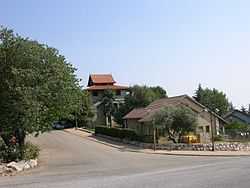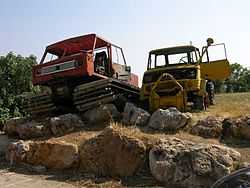Neve Ativ
| Neve Ativ נְוֵה אַטִי"ב | |
|---|---|
 | |
 Neve Ativ | |
| Coordinates: 33°15′42″N 35°44′28″E / 33.26167°N 35.74111°ECoordinates: 33°15′42″N 35°44′28″E / 33.26167°N 35.74111°E | |
| Council | Golan |
| Region | Golan Heights |
| Founded | 1972 |
| Population (2005) | 173 |

Neve Ativ (Hebrew: נְוֵה אַטִי"ב), is a small Alpine-styled Israeli settlement (moshav) in the Golan Heights, founded in 1972, and located on the slopes of Mount Hermon, 2 kilometers (1.2 mi) west of Majdal Shams.[1] The international community considers Israeli settlements in the Golan Heights illegal under international law, but the Israeli government disputes this.[2]
Community
About 37 families live there. The name Ativ is an acronym for four fallen soldiers from the Egoz Reconnaissance Unit killed in action in the Golan: Avraham Hameiri, Tuvia Ellinger, Yair Elegarnty, and Binyamin Hadad. Neve means Oasis.
Ski resort
The moshav's main industry is tourism. Neve Ativ operates the nearby Mount Hermon ski resort,[3] which has 25 kilometers (16 mi) of ski runs on the slopes of the 9,232 feet (2,814 m)-above-sea-level Mount Hermon.[4][5] The resort was destroyed in the 1973 Yom Kippur War, but re-opened the following year.[3]
Frank Riley wrote in the Los Angeles Times in 1981: "This is a mountain and an experience that should happen at least once in every skier's lifetime."[6] The ski season lasts three months, on average (December–March).[7] In one weekend in January 2000, the ski site had 11,000 visitors.[8] Later that month, the leaders of Neve Ativ expressed a hope to turn the ski resort into a joint Israeli-Syrian venture, with ski slopes on both sides of the ceasefire line.[9]
History
Israel and Syria fought major battles in the area in 1967 and 1973, and it remains a strategic military position.[10] Neve Ativ was built on the land of the destroyed Syrian village of Jubata ez-Zeit.[11][12] It was founded in 1972, when the Golan region was a part of the Israeli Military Governorate, governed by military occupation system. In 1981, the area of Golan was unilaterally annexed by Israel, abolishing military occupation system and imposing Israeli civil rule on the area.
In November 1996, a dining room in the settlement was set on fire and the walls on the building had "Down With the Occupation" and "The Golan Belongs to Syria" painted on them. Pro-Syrian Druze were believed to be behind it.[13]
See also
References
- ↑ Israel & the Palestinian territories, p. 271, Lonely Planet Israel, Michael Kohn, Lonely Planet, 2007, ISBN 1-86450-277-0, ISBN 978-1-86450-277-0, accessed December 18, 2009
- ↑ "The Geneva Convention". BBC. December 10, 2009.
- ↑ 3.0 3.1 "Ski resort back in business," Chicago Tribune, March 7, 1975, accessed December 18, 2009
- ↑ Sandler, Neil, "As Israelis debate the fate of the Golan, skiers and investors flock to its slopes", August 8, 1994, accessed April 18, 2015
- ↑ Gee, Robert W., "They're not heavenly, but the Holy Land has slopes," Austin American-Statesman, February 10, 2002, accessed December 18, 2009
- ↑ Riley, Frank, "Skiing Biblical Bashan Near Israel's Historic Treasures," Los Angeles Times, January 4, 1981, accessed December 18, 2009
- ↑ Kaplan, Janet, "Dive, rappel, cycle, plunge, snuba, soak, hike in Israel," Jweekly, September 10, 2009, accessed December 18, 2009
- ↑ Rudge, David, "Mt. Hermon swamped by 11,000 visitors," Jerusalem Post, January 10, 2000, accessed December 18, 2009
- ↑ "Hermon Ski Resort Hopes for Cooperative Management with Syrians," Israel Wire, January 20, 2000, accessed December 19, 2009
- ↑ Israel handbook: with the Palestinian Authority areas, Footprint handbooks, Dave Winter, Footprint Travel Guides, 1999, ISBN 1-900949-48-2, ISBN 978-1-900949-48-4, accessed December 19, 2009
- ↑ Murphy, R.; Gannon, D. (2008), "Changing The Landscape: Israel's Gross Violation of International Law in the occupied Syrian Golan", Yearbook of International Humanitarian Law (Cambridge University Press) 11: 139–174, p. 151
- ↑ Dar, Shimon (1993). Settlements and cult sites on Mount Hermon, Israel: Ituraean culture in the Hellenistic and Roman periods (Illustrated ed.). Tempus Reparatum. p. 168. ISBN 978-0-86054-756-3.
- ↑ David Rudge (1996-11-29). "Police probe series of arson attacks, Golan Druse suspected". The Jerusalem Post. Retrieved 2013-04-04.
| ||||||||||||||